Influence of Corrosion Damage on Fatigue Limit Capacities of Offshore Wind Turbine Substructure
Abstract
:1. Introduction
2. Theory of Fatigue Damage Analysis
2.1. Fatigue Analysis Using a Deterministic Method
2.2. Spectral Fatigue Analysis Method
2.3. Direct Formula Solution
2.4. Constant Amplitude Load Method
2.5. Weibull Corrosion Model
2.6. Long-Term Fatigue Analysis Method Considering Corrosion Effects
3. Basic Parameters of the OWT Infrastructure
3.1. Stress Hot-Spot Location
3.2. Corrosion Parameters
3.3. Load Data
4. Corrosion Fatigue Damage Analysis of Typical Tubular Joints
4.1. Finite-Element Modeling
4.2. Fatigue Damage under Equivalent Loads of the Wind Turbine and Wave Loads
4.3. Fatigue Damage under the Combined Equivalent Load of the Wind Turbine and Wave Load
5. Conclusions
- The cumulative fatigue damage of tubular joints in the foundation structure under the long-term wind turbine operating load, i.e., the equivalent fatigue wind turbine load, is considerably larger than the effect of the wave load, i.e., the wind turbine operating load is the main load causing the fatigue damage of the OWT structure.
- Under the joint influence of the long-term wind turbine operating load, wave load, and corrosion factors, the tubular joint damage accumulates continuously during the operation period. Compared with other types of tubular joints, the K-joint at the connection between the pile casing and strut is most significant. This is because it is considered as the control tubular joint for checking the ultimate fatigue-bearing capacity of the foundation structure.
- The fatigue accumulation results of the OWT foundation structure under the combined action of equivalent wind turbine load and wave load deviate for different calculation methods. The fatigue accumulation results of the OWT foundation structure under the combined action of the equivalent wind turbine load and wave load are largest for the equal-amplitude load method, followed by those obtained by the direct formula method and simple addition method.
- Considering the corrosion factors affecting the fatigue accumulation of the tubular joints in the basic structure in different operating periods, the three results have the same variation trend. They accumulate and increase with the increase in the wind turbine run-time. Therefore, the selection of the calculation method in the design of the infrastructure should consider the actual engineering situation. It should consider not only the importance of the safety of the OWT infrastructure, in order to avoid the over-estimation of the fatigue performance caused by the calculation result being smaller than the real value, but also the economic cost, in order to avoid economic waste caused by the calculation result being larger than the real value.
- Under the influence of the above complex environmental factors, the fatigue damage accumulation of the tubular joints of the foundation structure increases significantly. However, when the operation period reaches 30 years, the maximum fatigue damage accumulation of the tubular joints of the foundation structure is only 0.07, which is significantly smaller than the ultimate fatigue-bearing capacity of the tubular joints. The structural fatigue-bearing capacity still has a high degree of safety redundancy. This implies that, in the initial stage of offshore wind farm construction, the OWT infrastructure design method used in China is relatively conservative.
- At the present and subsequent stages of OWT infrastructure design, it is necessary to employ a more refined design method to reduce the cost of infrastructure design and construction. From the perspective of ultimate fatigue-bearing capacity, the evaluated OWT infrastructure is still in service, and thus, it is necessary to carry out a comprehensive evaluation of the bearing capacity of the foundation structure, propose reasonable safety protection strategies, prolong the service life, and improve the economic benefits of offshore wind farms.
Author Contributions
Funding
Institutional Review Board Statement
Informed Consent Statement
Data Availability Statement
Conflicts of Interest
References
- Shi, Z.; Wang, C.; Li, Q. Key issues in the development of China’s offshore wind power in the 14th Five-year Plan (Chinese). China Electr. Power 2020, 53, 8–11. [Google Scholar]
- Ren, Y.; Vengatesan, V.; Shi, W. Dynamic Analysis of a Multi-column TLP Floating Offshore Wind Turbine with Tendon Failure Scenarios. Ocean. Eng. 2022, 245, 110472. [Google Scholar] [CrossRef]
- Valamanesh, V.; Myers, T.; Arwade, R. Multivariate analysis of extreme metocean conditions for offshore wind turbines. Struct. Saf. 2015, 55, 60–69. [Google Scholar] [CrossRef]
- Peng, Z.; Zhao, H.; Li, X. New ductile fracture model for fracture prediction ranging from negative to high stress triaxiality. Int. J. Plast. 2021, 145, 103057. [Google Scholar] [CrossRef]
- Liu, Q.; Wei, K. Structural Reliability Analysis of Offshore Wind Turbine Jacket considering environmental corrosion. Acta Energ. Sol. Sin. 2021, 42, 394–400. [Google Scholar]
- Mehmanparast, A.; Vidament, A. An accelerated corrosion-fatigue testing methodology for offshore wind applications. Eng. Struct. 2021, 240, 112414. [Google Scholar] [CrossRef]
- Guo, H.; Wei, H.; Yang, D.; Liu, Y.; Wang, Z.; Tian, J. Experimental Study on Fatigue Performance of Q690 High-Strength Steel under Marine Corrosion Environment. China Civ. Eng. J. 2021, 54, 37–45. [Google Scholar]
- Han, Q.; Wang, X.; Lu, Y.; Qi, L. Corrosion Fatigue Life Assessment Method of Cast Steel and Butt Weld Based on Three-parameter Weibull Distribution Model. J. Build. Struct. 2021, 42, 213–220. [Google Scholar]
- Du, J.; Wang, H.; Wang, S.; Song, X.; Wang, J.; Chang, A. Fatigue damage assessment of mooring lines under the effect of wave climate change and marine corrosion. Ocean. Eng. 2020, 206, 107303. [Google Scholar] [CrossRef]
- Xie, M. Corrosion Fatigue Life Analysis of Tower of Offshore Wind Turbine; Lanzhou University of Technology: Lanzhou, China, 2016. [Google Scholar]
- Liao, X.; Qiang, B.; Wu, J.; Yao, C.; Wei, X.; Li, Y. An improved life prediction model of corrosion fatigue for T-welded joint. Int. J. Fatigue 2021, 152, 106438. [Google Scholar] [CrossRef]
- Wang, Y.; Shi, W.; Michailides, C.; Wan, L.; Kim, H.; Li, X. WEC shape effect on the motion response and power performance of a combined wind-wave energy converter. Ocean. Eng. 2022, 250, 111038. [Google Scholar] [CrossRef]
- Zhao, Z.; Shi, W.; Wang, W.; Qi, S.; Li, X. Dynamic analysis of a novel semi-submersible platform for a 10 MW wind turbine in intermediate water depth. Ocean. Eng. 2021, 237, 109688. [Google Scholar] [CrossRef]
- DNV. DNVGL-RP-C203; Fatigue Design of Offshore Steel Structures. DNV: Bærum, Norway, 2016.
- IEC 61400-1; Wind Turbines. Part 1: Design Requirements. IEC: Geneva, Switzerland, 2009.
- Wen, S.; Yu, Z. Wave Theory and Computational Principles (Chinese); Science Press: Beijing, China, 1984; pp. 430–437. [Google Scholar]
- IEC 61400-3; Wind Turbines. Part3: Design Requirements for Offshore Wind Turbines. IEC: Geneva, Switzerland, 2009.
- Wu, Z.; Jia, Y. Effect analysis of prestress on frequency by Equivalent Load Method. Concrete 2012, 4, 3. [Google Scholar]
- Qin, S.; Cui, W.; Shen, K. A Nonlinear Corrosion Model for Time-varying Reliability Analysis of Ship Structures. J. Ship Mech. 2003, 7, 94–103. [Google Scholar]
- Hao, Z. Characteristics and Influencing Factors of Marine Carbonate Systems in the Yellow Sea and Bohai Sea; Ocean University of China: Qingdao, China, 2015. [Google Scholar]
- Wu, L.; Fan, X.; Zhang, X.; Zhang, Y. Pilot scale study of membrane desalination in Bohai Bay. Water Treat. Technol. 2013, 39, 104–106. [Google Scholar]
- Matti, F.; Mashiri, F. Design formular for predicting the stress concentration factors of concrete-filled T-joints under out-of-plane bending. Structures 2020, 28, 2073–2095. [Google Scholar] [CrossRef]
- Zavvar, E.; Hectors, K.; De, W. Stress concentration factors of multi-planar tubular KT-joints subjected to in-plane bending moments. Mar. Struct. 2021, 78, 103000. [Google Scholar] [CrossRef]
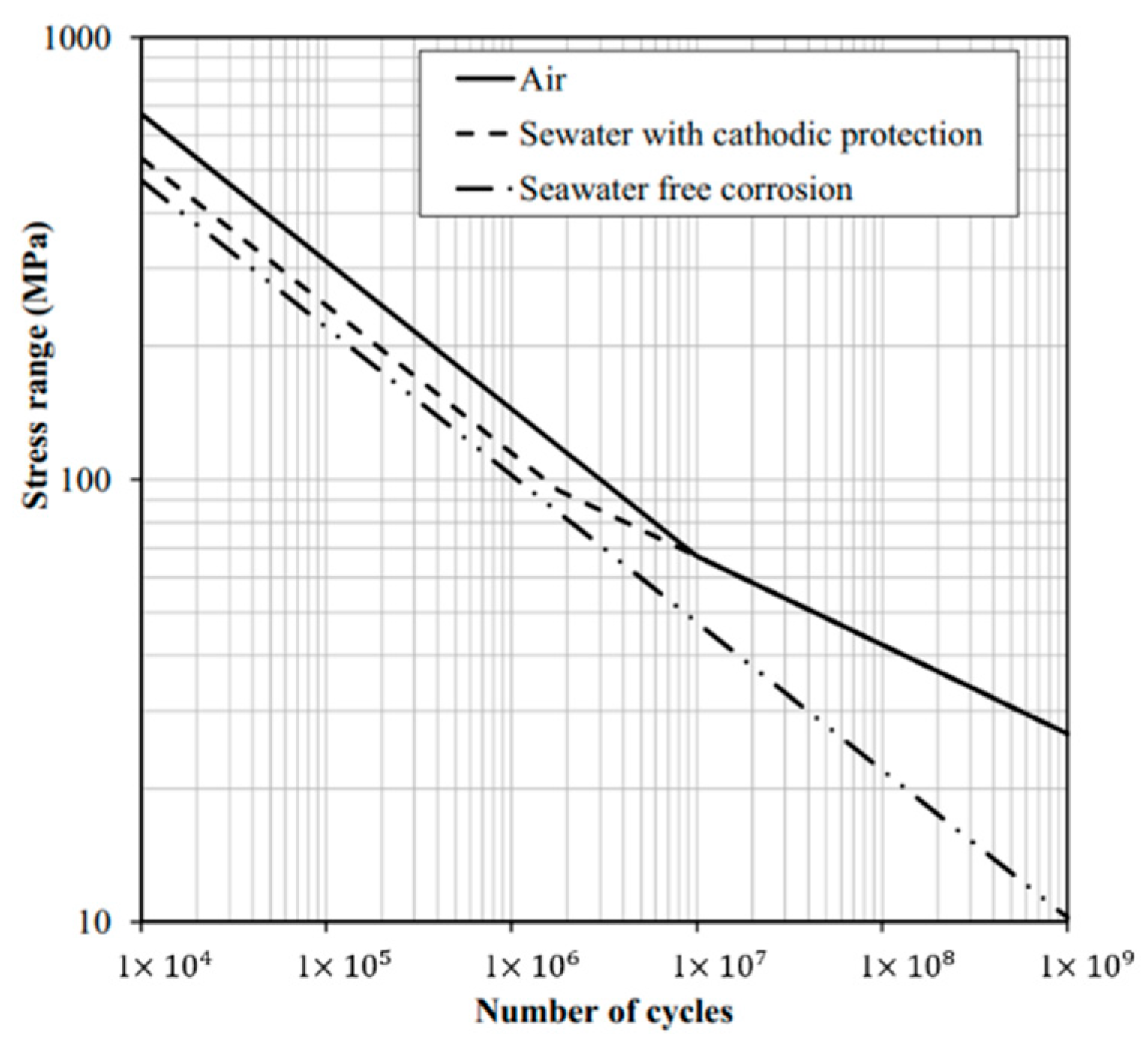

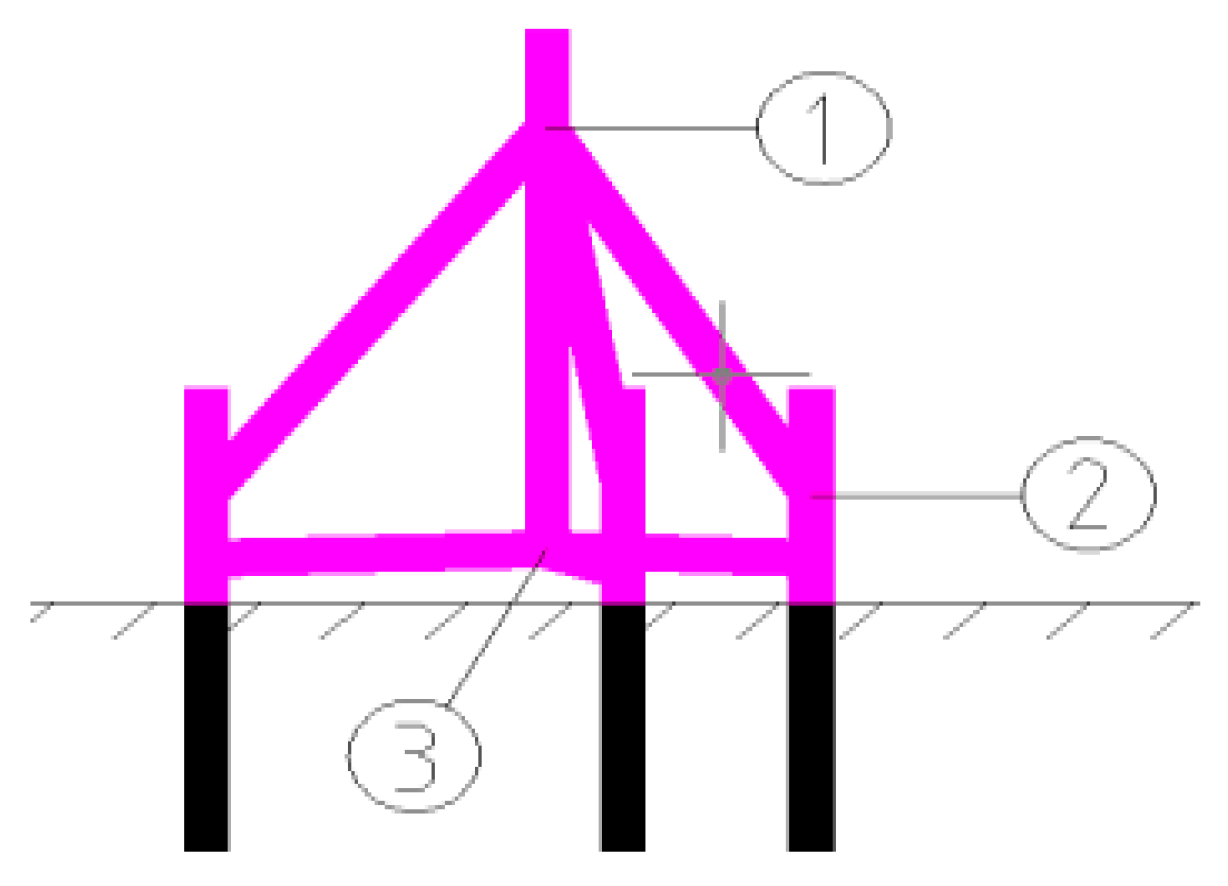
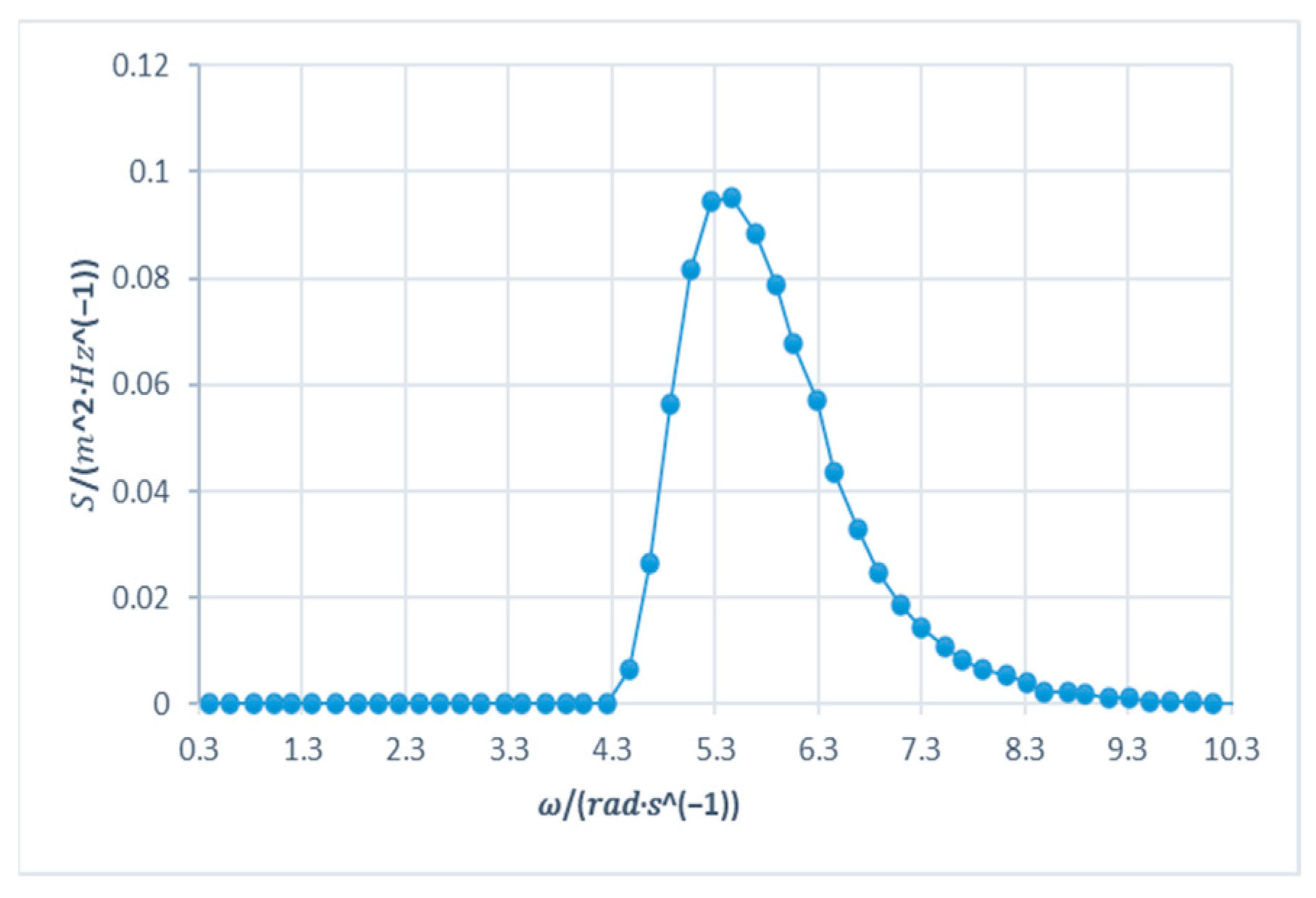

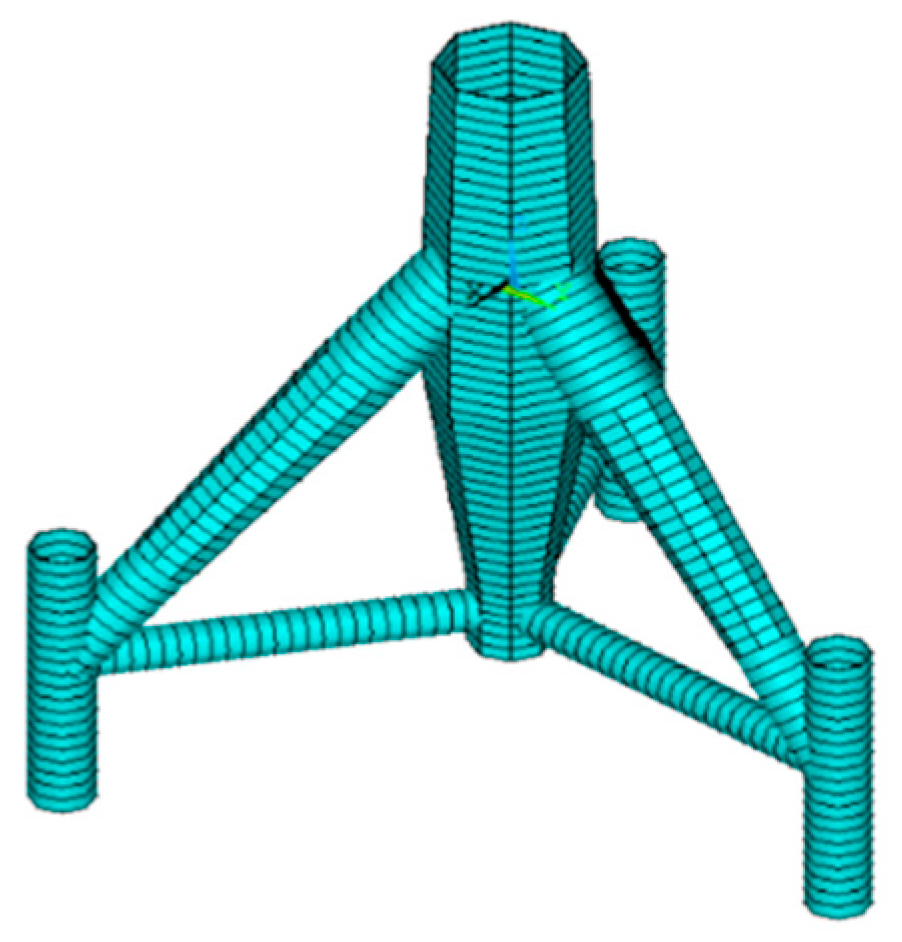
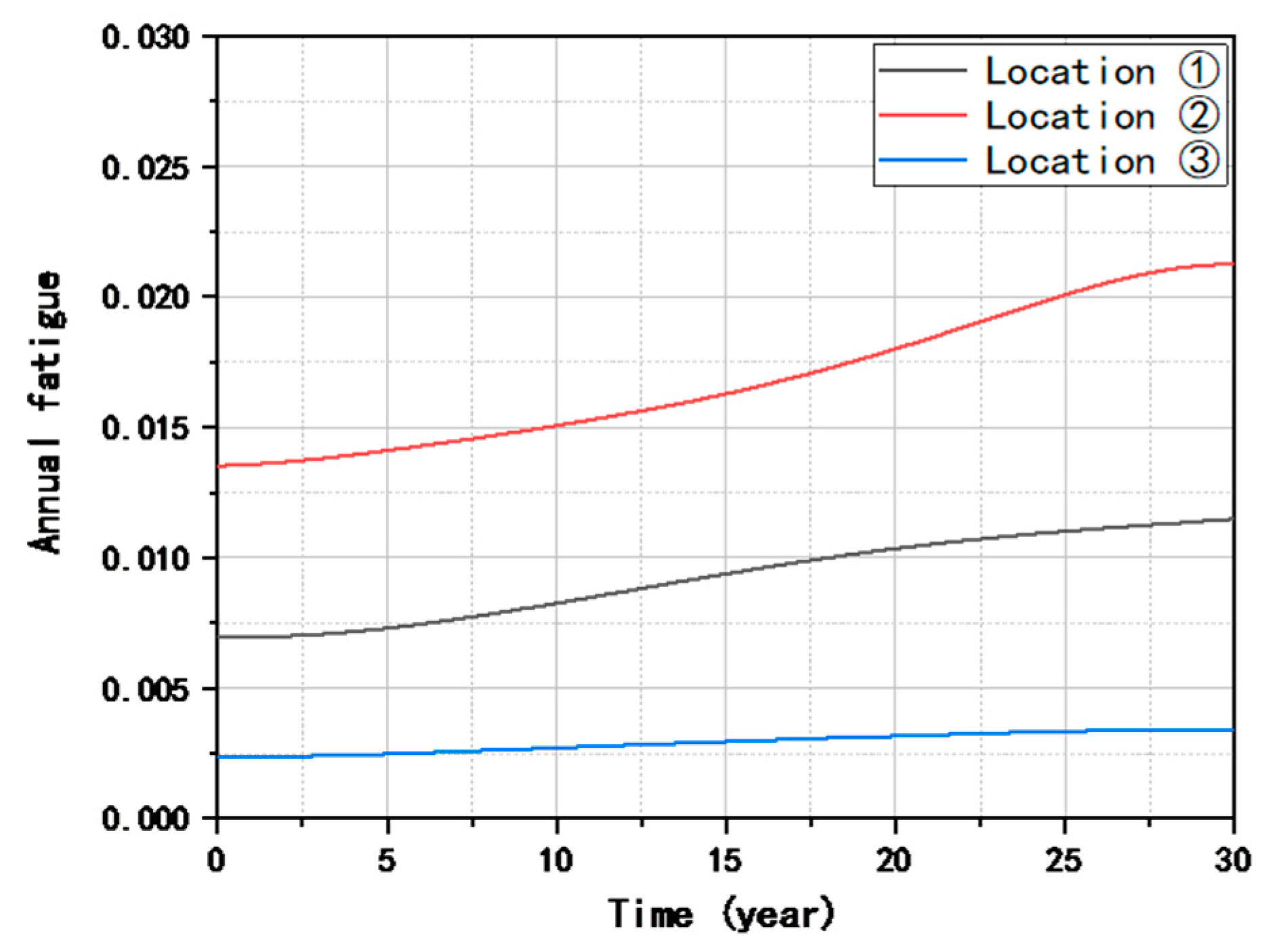
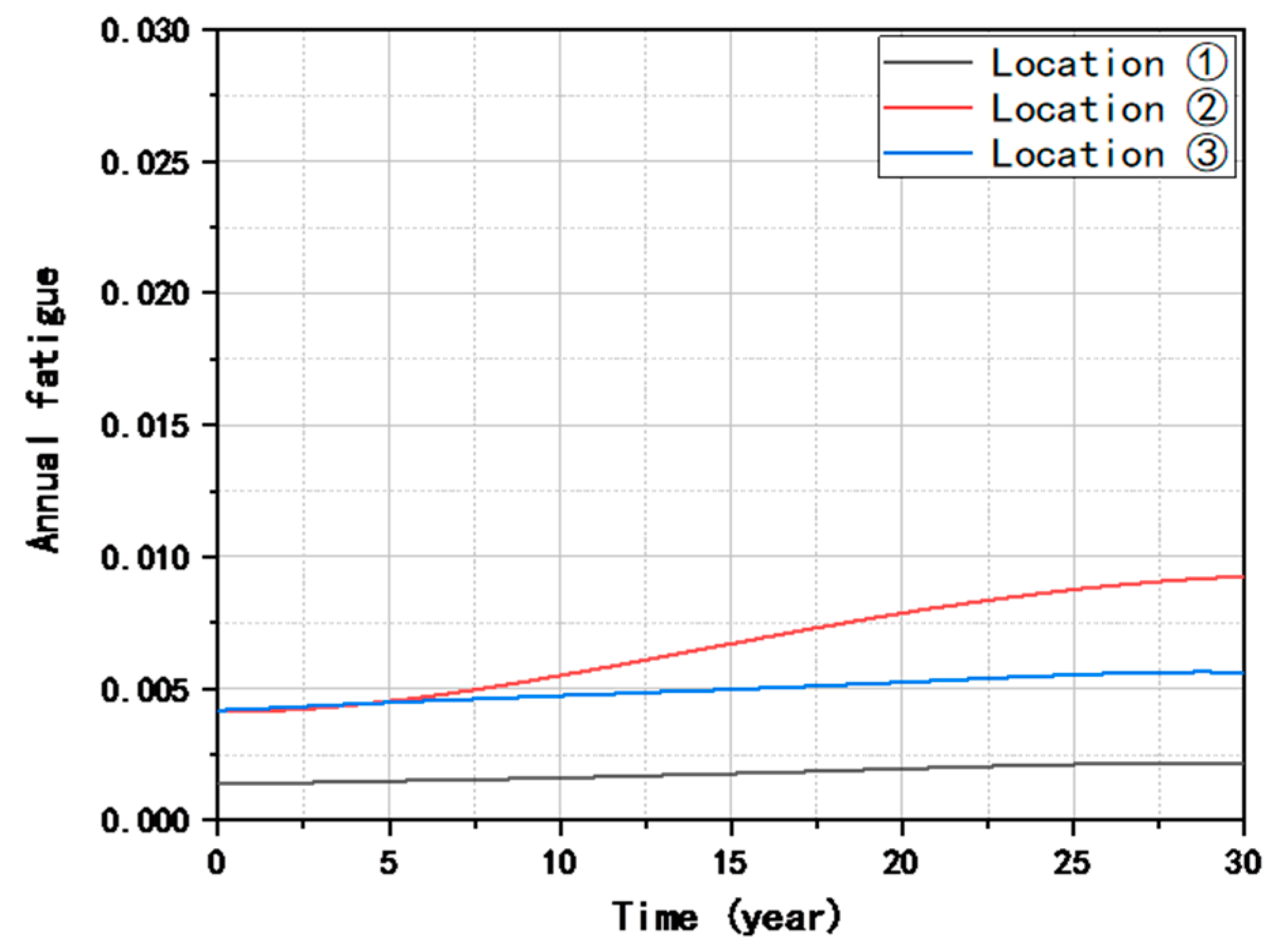

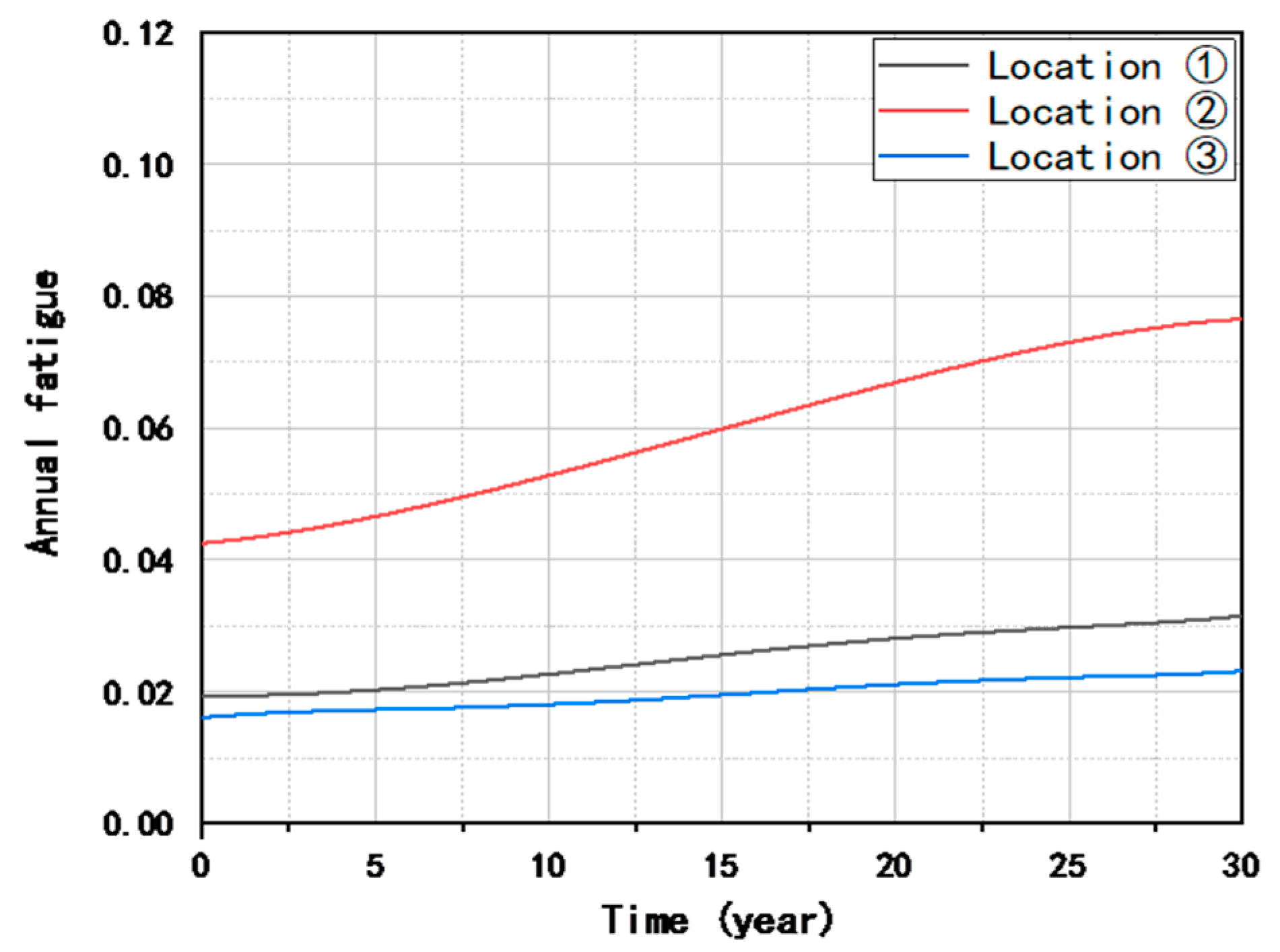
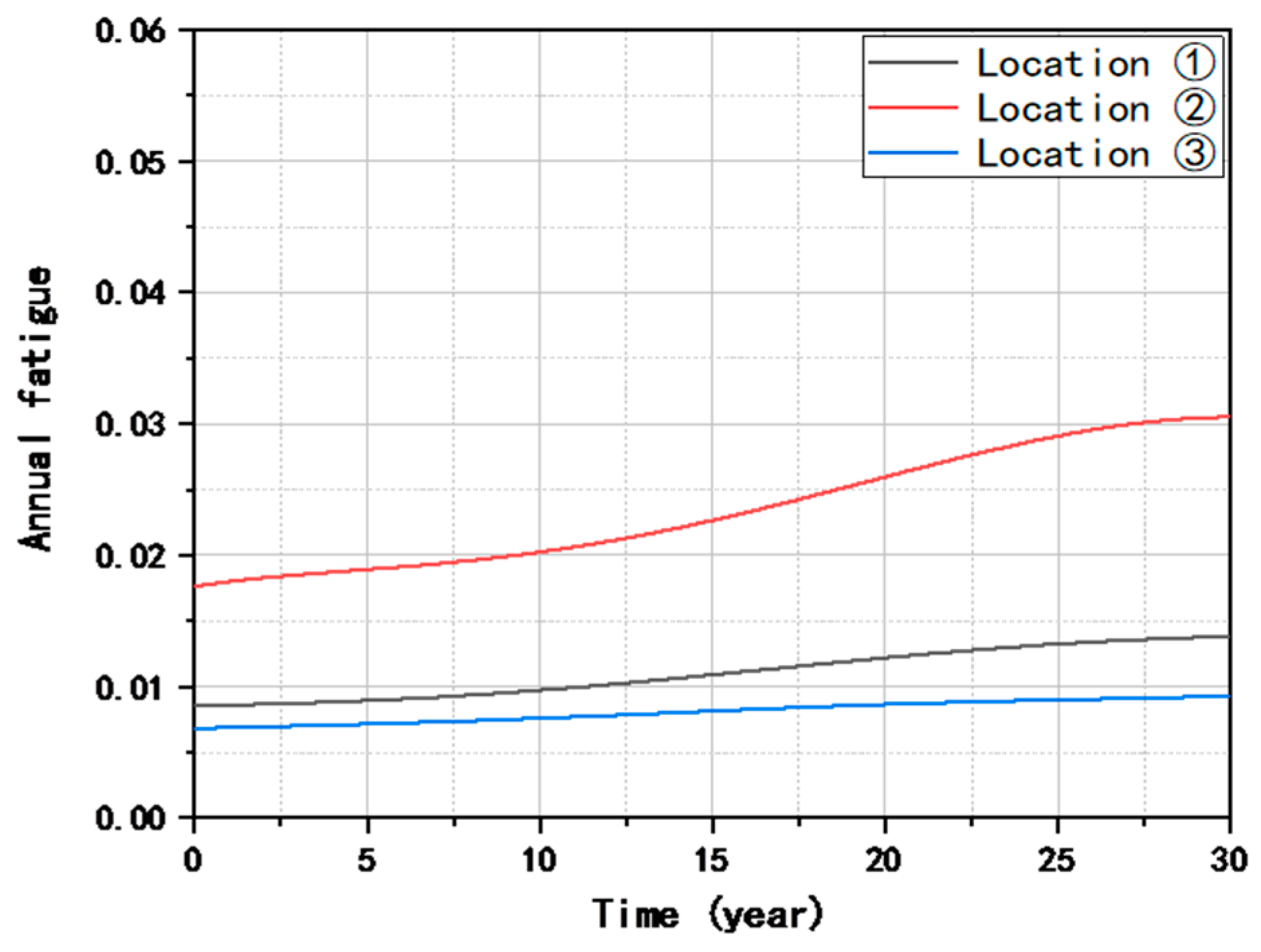
| m | Range of Valid Cycles | ||
|---|---|---|---|
| 11.764 | 3 | N < 106 | 0.25 |
| 15.606 | 5 | N > 106 | 0.25 |
| Part | Average Corrosion Rate (mm/Year) |
|---|---|
| Atmospheric area | 0.05–0.10 |
| Unprotected splash area | 0.40–0.50 |
| Water level fluctuation area, underwater area | 0.12 |
| Under the mud area | 0.05 |
| Part | Range (m) | Total Corrosion (mm) | ||
|---|---|---|---|---|
| 10 years | 20 years | 30 years | ||
| Atmospheric area | >6.338 | 0.93 | 1.75 | 2.75 |
| Splash area | 2.12~6.338 | 2.20 | 6.20 | 10.2 |
| Tide zone | −2.72~2.12 | 0.66 | 1.86 | 3.06 |
| Underwater area | −20.50~−2.72 | 0.66 | 1.86 | 3.06 |
| Under the mud area | ~−20.50 | 0.50 | 1.00 | 1.50 |
| Equivalent Fatigue Load Amplitude | Annual Cycle | |||||
|---|---|---|---|---|---|---|
| Mx(kN·m) | My(kN·m) | Mz(kN·m) | Fx(kN) | Fy(kN) | Fz(kN) | |
| 0 | 0 | 0 | 0 | 0 | 18.925 | 2.50 × 107 |
| 0 | 0 | 0 | 41.68 | 0 | 18.925 | 1.82 × 107 |
| 0 | 0 | 1053 | 41.68 | 91.35 | 18.925 | 1.26 × 107 |
| 6900 | 0 | 1053 | 41.68 | 91.35 | 18.925 | 5.30 × 106 |
| 6900 | 3165.5 | 1053 | 41.68 | 91.35 | 18.925 | 4.96 × 106 |
| 6900 | 3165.5 | 2106 | 41.68 | 91.35 | 37.85 | 1.84 × 106 |
| 6900 | 3165.5 | 2106 | 83.35 | 182.7 | 37.85 | 6.90 × 105 |
| 13,800 | 6330 | 2106 | 83.35 | 182.7 | 56.75 | 3.30 × 105 |
| 13,800 | 6330 | 3159 | 125.05 | 182.7 | 56.75 | 1.64 × 105 |
| 13,800 | 9495 | 4212 | 125.05 | 274.05 | 56.75 | 5.50 × 104 |
| 20,700 | 9495 | 4212 | 166.7 | 274.05 | 75.7 | 3.63 × 104 |
| 20,700 | 12,665 | 5265 | 208.4 | 274.05 | 75.7 | 1.41 × 104 |
| 20,700 | 15,830 | 5265 | 208.4 | 365.4 | 94.6 | 6.05 × 103 |
| 27,605 | 15,830 | 5265 | 250.1 | 365.4 | 94.6 | 3.33 × 103 |
| 34,505 | 18,995 | 6320 | 250.1 | 456.75 | 138.55 | 1.14 × 103 |
| 41,405 | 18,995 | 7370 | 291.75 | 548 | 132.45 | 3.42 × 102 |
| 41,405 | 22,160 | 8425 | 333.45 | 548 | 132.45 | 1.43 × 102 |
| Method | Location | Fatigue Damage | ||
|---|---|---|---|---|
| 10 years | 20 years | 30 years | ||
| the direct formula method | ① | 0.01295 | 0.01602 | 0.01788 |
| ② | 0.03171 | 0.04174 | 0.04816 | |
| ③ | 0.01344 | 0.01539 | 0.01649 | |
| the equal-amplitude load method | ① | 0.02251 | 0.02789 | 0.03116 |
| ② | 0.05176 | 0.06692 | 0.07651 | |
| ③ | 0.01835 | 0.02112 | 0.02267 | |
| the simple addition method | ① | 0.00986 | 0.01224 | 0.01369 |
| ② | 0.02118 | 0.02696 | 0.03062 | |
| ③ | 0.00739 | 0.00847 | 0.00908 | |
Publisher’s Note: MDPI stays neutral with regard to jurisdictional claims in published maps and institutional affiliations. |
© 2022 by the authors. Licensee MDPI, Basel, Switzerland. This article is an open access article distributed under the terms and conditions of the Creative Commons Attribution (CC BY) license (https://creativecommons.org/licenses/by/4.0/).
Share and Cite
Li, Y.; Zhang, Y.; Wang, W.; Li, X.; Wang, B. Influence of Corrosion Damage on Fatigue Limit Capacities of Offshore Wind Turbine Substructure. J. Mar. Sci. Eng. 2022, 10, 1011. https://doi.org/10.3390/jmse10081011
Li Y, Zhang Y, Wang W, Li X, Wang B. Influence of Corrosion Damage on Fatigue Limit Capacities of Offshore Wind Turbine Substructure. Journal of Marine Science and Engineering. 2022; 10(8):1011. https://doi.org/10.3390/jmse10081011
Chicago/Turabian StyleLi, Ying, Yu Zhang, Wenhua Wang, Xin Li, and Bin Wang. 2022. "Influence of Corrosion Damage on Fatigue Limit Capacities of Offshore Wind Turbine Substructure" Journal of Marine Science and Engineering 10, no. 8: 1011. https://doi.org/10.3390/jmse10081011
APA StyleLi, Y., Zhang, Y., Wang, W., Li, X., & Wang, B. (2022). Influence of Corrosion Damage on Fatigue Limit Capacities of Offshore Wind Turbine Substructure. Journal of Marine Science and Engineering, 10(8), 1011. https://doi.org/10.3390/jmse10081011






